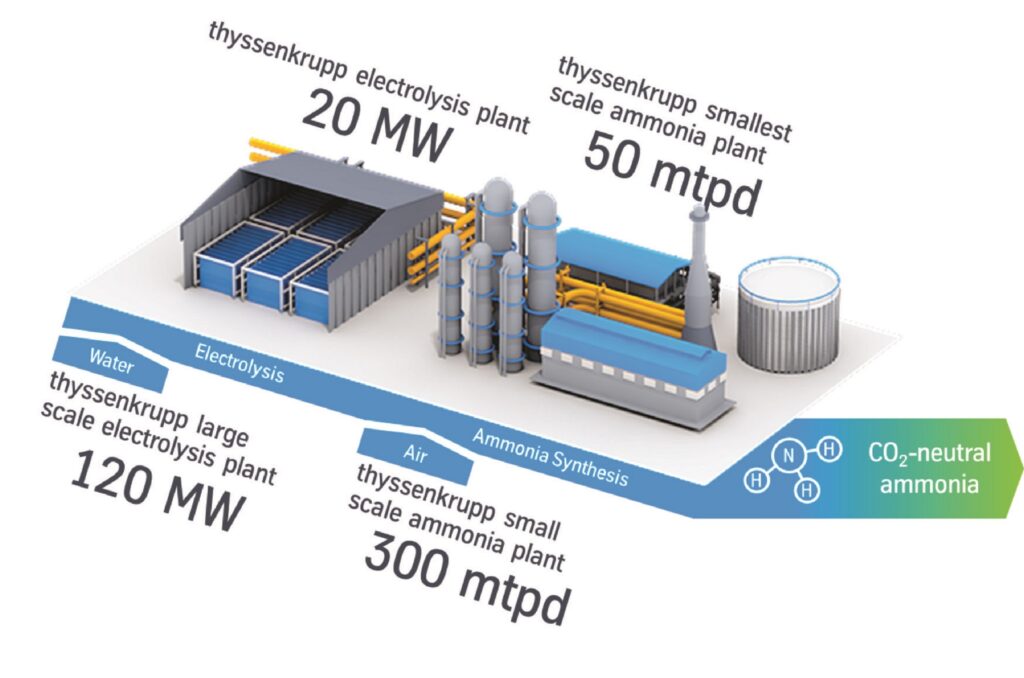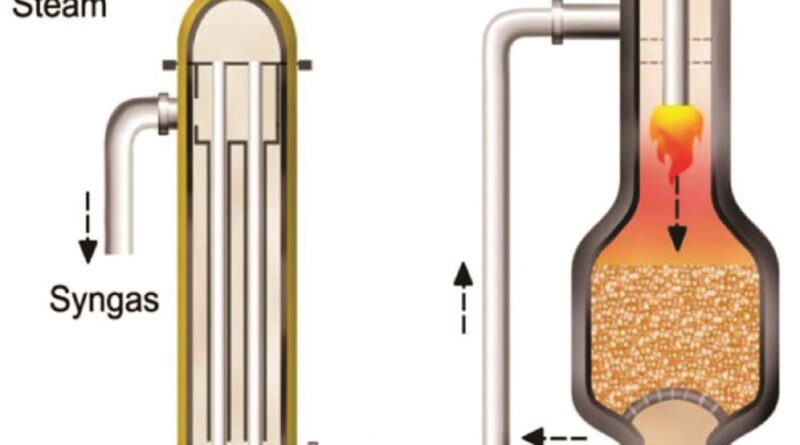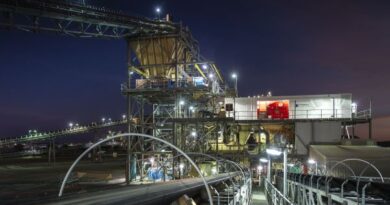Reduce CO2 and costs: Ammonia Solutions from thyssenkrupp Uhde

Ammonia is a highly versatile chemical compound that is used by many industries for a variety of applications. The mining sector uses ammonia for the extraction of elements (copper and molybdenum) and metals (nickel) from ores. Ammonia is employed to cleanse exhaust gases from smokestacks, removing sulfur oxides and NOx, thereby enhancing the efficiency of electrostatic precipitators. The chemical compound also serves to regulate the pH in water in the treatment of wastewater. The ammonia that is used in these applications is produced by the reforming of carbon-based fuels (coal or natural gas).
Despite its essential use, mining companies face mounting pressure to reduce their carbon footprint and to transition to more sustainable practices. With this in mind, thyssenkrupp Uhde has developed an ammonia production solution based on renewable feedstocks that is 100% CO2-free. Production of ammonia that is CO2-free is designated as green ammonia. Besides climate considerations, other drivers of the move to distribute production of green ammonia from small-scale plants have been the desire for localised self-sufficiency, avoidance of high transportation costs and import or carbon taxes.
“Whereas in conventional ammonia plants, ammonia is produced by steam reforming natural gas, thyssenkrupp Uhde’s green ammonia process is underpinned by green hydrogen produced by electrolysis,” says Nithesh Mohun, Business Development Manager at thyssenkrupp Uhde.
According to Mohun, the feedstocks for the green ammonia production are hydrogen, water and renewable power. Renewable power is produced by either solar PV, wind, hydropower or a combination thereof. Explaining green ammonia production, Mohun says, “Within the electrolysis plant, water is converted into green hydrogen by the application of direct electrical current. Nitrogen is produced in an air separation unit (ASU).”
For the production of green ammonia, thyssenkrupp Uhde has developed solutions with capacities ranging from 300 tpd up to 5 000 tpd. “Our smaller scale plants in capacity classes 300 tpd, 600 tpd and 1200 tpd are offered on a fully modularized basis,” adds Mohun. The plants would be fabricated, pre-assembled and pre-commissioned as skids for easy transportation. Limitation for modularization is typically the shipping envelope. Subsequently, larger plant capacities are primarily considered being executed on a stick-built approach.
Nevertheless, even greater capacities are further developed considering more modularization. Mohun adds that the key is standardization to maximum extent in order to ease execution. The hydrogen and ammonia modular solutions are matched. For example, the 300 tpd module is paired with a 120 MW plant.
Modularization provides benefits in addition to the underlying technology. These include reduced implementation timeframes, improved quality control, reduced project investment cost through lower contingency requirements and greater risk mitigation through significant reduction of on-site construction effort and time.
Small-scale ammonia plants have the advantage of distributed production location and reduction of logistics risks and costs. The small-scale plant can be designed to service the immediate market and thus limit capital outlay and transportation of large consignments of the product as well as logistics risks in off-loading and storage.
Small-scale green ammonia plants can compete with conventional plants under the right frame conditions. The key drivers for green ammonia competitiveness are reduced capital expenditure, cost effective renewable power supply and stringent CO2 taxes and penalties. In most parts of the world renewable power is now more affordable than power produced from fossil fuels. Capital costs for green ammonia plants are falling with increased research and development efforts. Governments and environmental organizations are strongly driving enforcement of CO2 taxes and penalties. “Considering the above, green ammonia can already today reach price parity with conventional ammonia production, e.g. by leveraging CO2 incentives and eliminating the need to import ammonia over long distances,” states Mohun.
When the project focus is on conventional ammonia production, thyssenkrupp Uhde offers the modular A01 and A04 series Gas Heater Reformer (GHR) solution with capacities ranging from 50 – 350 tpd. The GHR solution was developed in collaboration with Johnson Matthey. The system is based on gas heated reforming (GHR) technology with a pressure swing adsorption (PSA) system at the front end and thyssenkrupp Uhde low-pressure synthesis loop at the back end. The design is less complicated than a conventional primary/secondary reformer and is especially suited for small capacities with low ammonia needs and high transportation challenges. The GHR is a cost-effective solution as it eliminates the need for an externally- fired primary reformer, the elaborate waste heat-recovery section and the consequent excess steam production.
Moreover, as the reforming operates with air, there is no need for an air separation unit. The modular nature of the GHR offers, amongst others, reduced implementation timeframes, improved quality control and reduced project investment.
thyssenkrupp Uhde also offers conventional ammonia production plants up to 5 000 tpd based on Uhde ammonia technology with almost a century of experience and more than 130 plants built, resulting in total to about 50 million tons per annum equivalent.




